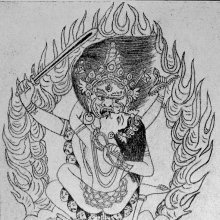Candaroshana, Caṇḍaroṣaṇa: 1 definition
Introduction:
Candaroshana means something in Buddhism, Pali. If you want to know the exact meaning, history, etymology or English translation of this term then check out the descriptions on this page. Add your comment or reference to a book if you want to contribute to this summary article.
The Sanskrit term Caṇḍaroṣaṇa can be transliterated into English as Candarosana or Candaroshana, using the IAST transliteration scheme (?).
Alternative spellings of this word include Chandaroshana.
Images (photo gallery)
In Buddhism
Tibetan Buddhism (Vajrayana or tantric Buddhism)
Source: archive.org: The Indian Buddhist IconographyCaṇḍaroṣaṇa (चण्डरोषण) refers to one of the various emanations of Akṣobhya having their Sādhana described in the 5th-century Sādhanamālā (a collection of sādhana texts that contain detailed instructions for rituals).—His Colour is yellow; his Symbols are the sword and tarjanīpāśa; he has two arms.—Caṇḍaroṣaṇa is also called Mahācaṇḍaroṣaṇa, Caṇḍamahāroṣaṇa and Acala. Four Sādhanas are devoted to his worship and he is always represented in yab-yum. Prabhākarakīrti is said to be the author of one of the Sādhanas the major portion of which is is verse.
It should be noticed that the Dhyāna is silent about the Śakti in whose embrace the god should remain in yab-yum, but if the Buddhist priests are to be believed and if the testimony of the Nepalese Citrakāras has any value, it must be assumed that Caṇḍaroṣaṇa is always represented in yab-yum and should not be represented singly. Caṇḍaroṣaṇa is the most important figure in the celebrated Caṇḍamahāroṣaṇa-tantra dedicated to his worship. His worship is always performed in secret and the god is kept secluded from public gaze. Even if there be a bronze image it is practically inaccessible to any one except the initiated.

Tibetan Buddhism includes schools such as Nyingma, Kadampa, Kagyu and Gelug. Their primary canon of literature is divided in two broad categories: The Kangyur, which consists of Buddha’s words, and the Tengyur, which includes commentaries from various sources. Esotericism and tantra techniques (vajrayāna) are collected indepently.
See also (Relevant definitions)
Ends with: Mahacandaroshana.
Full-text: Mahacandaroshana, Acala, Vajrabhishana, Candamaharoshana, Trailokyavijaya.
Relevant text
Search found 1 books and stories containing Candaroshana, Caṇḍaroṣaṇa, Candarosana; (plurals include: Candaroshanas, Caṇḍaroṣaṇas, Candarosanas). You can also click to the full overview containing English textual excerpts. Below are direct links for the most relevant articles:
The Indian Buddhist Iconography (by Benoytosh Bhattachacharyya)
